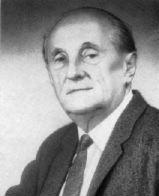

Steinhaus studied for a year in Lvov, spent a term in Munich but then spent 5 years studying mathematics at the University of Göttingen. There he
was influenced by an amazingly strong group of mathematicians including Felix Bernstein, Carathéodory, Courant, Herglotz, Hilbert, Klein, Koebe,
Landau, Runge, Toeplitz, and Zermelo. He completed his doctorate with distinction under Hilbert in 1911.
The main influence on the direction that Steinhaus's research would take was from Lebesgue. Steinhaus studied Lebesgue's two major books around 1912 after completing his doctorate.
After military service in the Polish Legion at the beginning of World War I, Steinhaus lived in Kraków. Soon after, he founded the Polish Mathematical Society.
Also at this time Steinhaus started a collaboration with Banach, and their first joint work was completed in 1916.
Steinhaus then took a position at the Jan Kazimierz University in Lvov with Banach. The school concentrated mainly on functional
analysis and its diverse applications, the general theory of orthogonal series, and probability theory. There is no doubt that none of these theories
would have achieved today's level of prominence without an essential understanding of the Lebesgue measure and integral. On the other hand, the
ideas of Lebesgue measure and integral found their most striking and fruitful applications there in Lvov.
Steinhaus was the main figure in the Lvov School until 1941. In 1923 he published the first rigorous account of the
theory of tossing coins based on measure theory. In 1925 he was the first to define and discuss the concept of strategy in game theory. Together with Banach in 1929, he started a
new journal Studia Mathematica.
Another important publishing venture in which Steinhaus was involved, begun in 1931, was a new series of Mathematical Monographs. An important
contribution to the series was a volume written by Steinhaus and Kaczmarz in 1937, The theory of orthogonal series.
The mathematicians of the Lvov school did a great deal of mathematical research in the cafés of Lvov. The Scottish Café was the most popular with the
mathematicians in general, and it is there that the famous Scottish Book consisting
of open questions posed by the mathematicians working there came into being. Steinhaus contributed ten problems to the book, including the final one only days before the Nazi troops entered the town.
When the prospect of war was looming in 1938, Steinhaus proposed Lebesgue for an honorary degree from Lvov, which he received. Steinhaus spent the war years hiding from the Nazis,
suffering great hardships, going hungry most of the time but always thinking about mathematics.
In 1945, Steinhaus moved to the University of Wroclaw but made many visits to universities in the United States, including Notre Dame.
The Scottish Book seems to have been preserved through the war by Steinhaus.
In 1944, Steinhaus proposed the problem of
dividing a cake into n pieces so that it is proportional and envy free. For n = 2 the problem is trivial: one person cuts the cake, the other chooses their piece. Steinhaus found a proportional but not envy free solution for n = 3. An envy free solution to Steinhaus's problem for n = 3 was found in 1962 by John H. Conway and, independently, by John
Selfridge. For general n the problem was solved by Steven Brams and Alan Taylor in 1995.
Steinhaus's bibliography contains 170 articles. He did important work on functional analysis. Some of Steinhaus's early work was on trigonometric series. He was the first to give some examples which would lead to
marked progress in the subject. He gave an example of a trigonometric series which diverged at every point, yet its coefficients tended to zero. He also gave
an example of a trigonometric series which converged in one interval but diverged in a second interval. Other contributions by Steinhaus were on orthogonal series, probability theory, real functions and their applications. In particular
he is associated with the theory of independent functions, arising from his work in probability theory, and he was the first to make precise the concepts of
"independent" and "uniformly distributed". Steinhaus is best known for his book Mathematical Snapshots written in 1937.